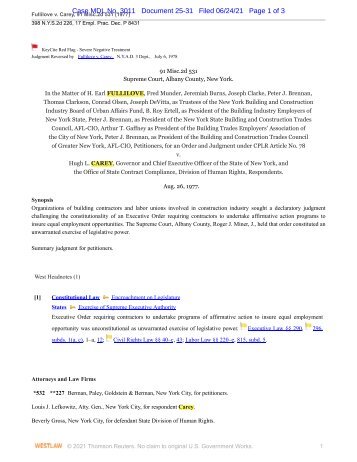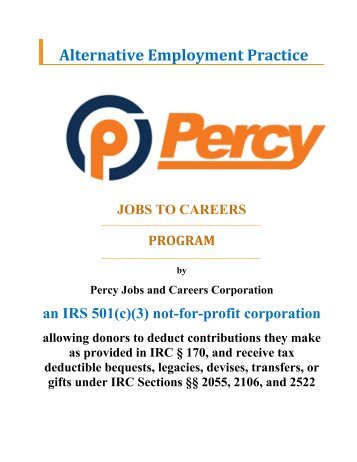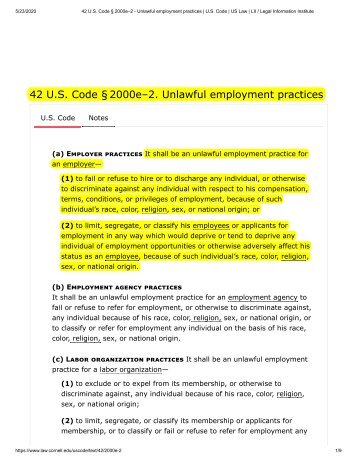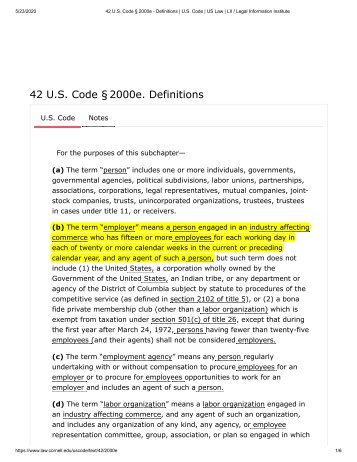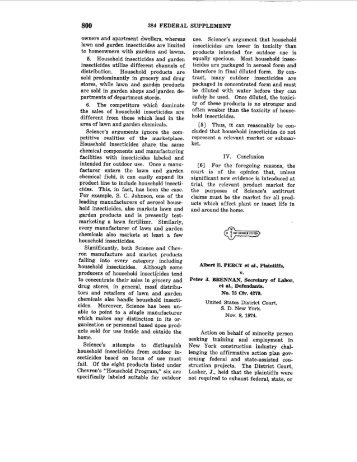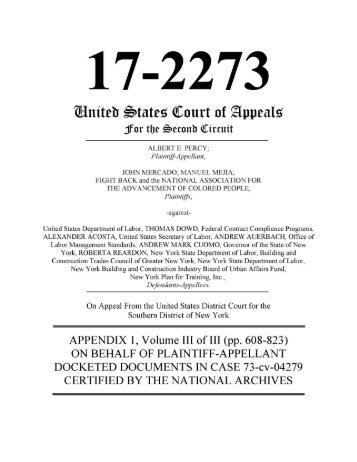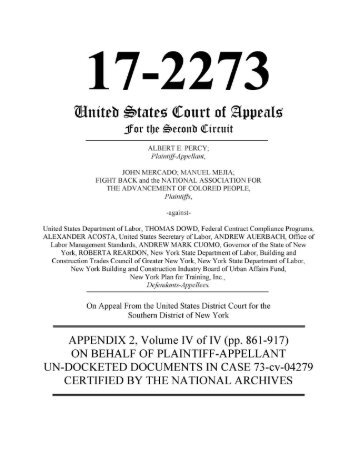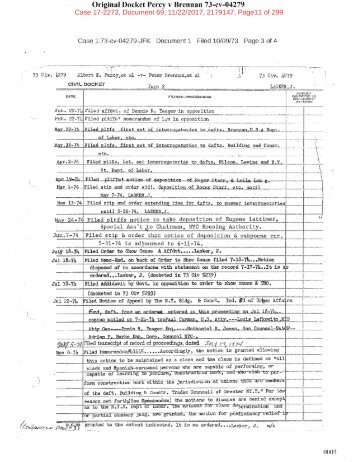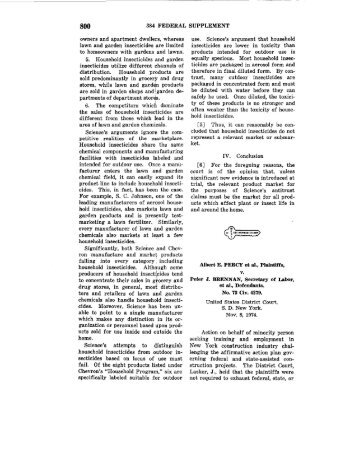The Percy Program
It is a fight to level the playing field to be able to compete for jobs and careers on the basis of skills and make available apprentice training to all. In 1973 Al Percy launched a class action lawsuit to give workers like him a chance to better their lot in life. It would also ensure the availability of skilled workers to build the infrastructure of the future.
Percy Program - Alternative Employment Practice EDNY 20-cv-06131
- Text
- Percy
- Workers
- Compensation
- Pageid
- Apprenticeship
- Osha
- Assessment
- Coverage
- Items
- Employment
- Edny
Case
Case 1:20-cv-06131-CLP Document 22-21 Filed 03/14/21 Page 14 of 64 PageID #: 2746 also available for job-seekers in the general workforce to make themselves more marketable. These classes include many OSHA classes, Department of Building-required training, first aid, emergency planning, and fire safety courses. OSHA Workplace Hazards Addressed Occupational Safety and Health Act of 1970 Section 5(a)(1), “General Duties Clause”, recognizes hazards in the workplace that are causing or are likely to cause death or serious physical harm, including from airborne infectious diseases. Mitigation is by engineering and administrative controls, and by safe work practices. Personal protective equipment (PPE, including goggles, face mask, gowns) as may be necessary, to assist medications, including IV, oxygen monitoring, and administration of bathing, personal care in hospitalization, home health care and nursing home settings. Engineering controls include mechanical methods of separating an employee from a workplace danger, air filtration systems or physical barriers, sneeze guards. Administrative controls changing human behavior to reduce exposure to a hazard, encouraging sick employees to stay home, keep workers six feet apart from each other and reducing unnecessary travel to locations with coronavirus outbreaks. Safe work practices provide disinfecting products so employees can clean their work surfaces. Working in personal protective equipment (PPE) including masks, gloves, hard hats, eye protection and respirators, nurse working triage in hospitals. Apprentices and journeyperson employees receive various work experiences listed below (customized to the needs of specific employers, local requirements and specific care settings). The apprentice will learn and practice the competencies working with a mentor on the work site. Each Apprentice(s) and journeyperson employees shall be instructed in safe and healthful work practices and shall ensure that apprentice(s) are trained in facilities and other environments in cleaning, decontamination and disinfection, area specific safety standards, OSHA/blood borne pathogens, microbiology (e.g. cross contamination, chain of infection, microbial transmission, how CS supports infection prevention), where to obtain area specific safety awareness standards (e.g. safety data sheets (SDS) by regulatory agencies and professional associations), Preparing work area for decontamination, correct cleaning agent or chemicals for cleaning process, supplies needed (e.g. brush, towels, location of restock), equipment (e.g. washer disinfector, ultrasonic, cart washer, leak tester), determine and prepare chemicals following the manufacturer's IFU (e.g. dilution, equipment), check and replenish chemicals in equipment, determine the correct chemicals for the equipment, testing the functionality of light and magnification devices, clean sink strainer/drains (e.g. frequency), quality tests, efficacy testing process for washer/disinfector, efficacy 12 | Page
Case 1:20-cv-06131-CLP Document 22-21 Filed 03/14/21 Page 15 of 64 PageID #: 2747 testing process for ultrasonic, efficacy testing process for automated endoscope reprocessor (AER), Efficacy testing process for cart washer, frequency of quality tests (e.g. washers, ultrasonic, AERs, cart washers), document and interpret quality test results (e.g. quality assurance testing program), maintenance and troubleshooting of equipment, interpret the manufacturer's IFU (e.g. operator's manual, locate), identify, respond and report malfunctions and/or alarms, clean equipment strainers/drains, Identification of outlets (e.g. on/off, regular, emergency), chemical feed line functionality (e.g. identifying detergent dosage), clean and test spray arms, check washer manifolds and baskets, identification and separation of reusable and disposable items, sorting reusable and disposable items (e.g. laparoscopic tips, linens, drapes, third-party recycling vendors, sustainability), dispose of sharps and non-reprocessed items (e.g. biohazards vs non-regulated trash, sharps container), preparing items for decontamination, identify manual and/or mechanical cleaning according to the manufacturer, Proper opening and positioning of instruments, disassemble instruments, what goes in each sink (e.g. two or three sink method), soak process (e.g. water temperature, dilution), brushes (e.g. selection, size and care, single use vs reusable), prevention of aerosols, Use of high-pressure water and air gun/hose (e.g. critical water), visual inspection of bioburden removal (e.g. magnifying devices), properly load items into the equipment, selection of appropriate wash cycle, methods for reducing the risk of toxic anterior segment syndrome (TASS), special precautions for Creutzfeldt-Jacob Disease (CJD) instruments, selecting and using appropriate disinfectant, disinfectant family (e.g. Quats, Halogens, Aldehydes), three levels of Spaulding classification (e.g. non-critical, semi-critical, critical), Identify, select and use the appropriate chemicals (e.g. exposure times, rinsing), documentation of chemical testing (e.g. temperature, minimum effective concentration(MEC)), Corrective actions for failed quality tests (e.g. temperature, MEC), high level disinfection (HLD) process, safety measures when using HLD (e.g. PPE, spill kit, ventilation), dilution requirements (e.g. concentration, expiration, end of use date, labeling), Rinsing requirements (e.g. critical water), proper documentation (e.g. technician information, patient information, exposure time and solution temperature, lot control number), are, handling and storage (e.g. drying, expiration date), proper disposal methods (e.g. neutralizer), Transport guidelines (e.g. closed container, clean labeling), transferring items to preparation area, maintain appropriate air flow (e.g. negative pressure, positive pressure), prevent cross-contamination (e.g. point of use cleaning and decontamination prior to IUSS), performing a visual check for cleanliness, preparation and packaging, area specific safety standards, area specific safety awareness (e.g. hot carts, wet floors, hot trays), sharps safety (e.g. skin hooks, k-wire, towel clips), equipment operation (e.g. heat sealers, insulation testers, scope inspectors), where to find Safety Data Sheets (SDS), chemical safety and handling (e.g. interpreting the manufacturer's instructions for use (IFU) 13 | P age
- Page 1 and 2: Case 1:20-cv-06131-CLP Document 22-
- Page 3 and 4: Case 1:20-cv-06131-CLP Document 22-
- Page 5 and 6: Case 1:20-cv-06131-CLP Document 22-
- Page 7 and 8: Case 1:20-cv-06131-CLP Document 22-
- Page 9 and 10: Case 1:20-cv-06131-CLP Document 22-
- Page 11 and 12: Case 1:20-cv-06131-CLP Document 22-
- Page 13: Case 1:20-cv-06131-CLP Document 22-
- Page 17 and 18: Case 1:20-cv-06131-CLP Document 22-
- Page 19 and 20: Case 1:20-cv-06131-CLP Document 22-
- Page 21 and 22: Case 1:20-cv-06131-CLP Document 22-
- Page 23 and 24: Case 1:20-cv-06131-CLP Document 22-
- Page 25 and 26: Case 1:20-cv-06131-CLP Document 22-
- Page 27 and 28: Case 1:20-cv-06131-CLP Document 22-
- Page 29 and 30: Case 1:20-cv-06131-CLP Document 22-
- Page 31 and 32: Case 1:20-cv-06131-CLP Document 22-
- Page 33 and 34: Case 1:20-cv-06131-CLP Document 22-
- Page 35 and 36: Case 1:20-cv-06131-CLP Document 22-
- Page 37 and 38: Case 1:20-cv-06131-CLP Document 22-
- Page 39 and 40: Case 1:20-cv-06131-CLP Document 22-
- Page 41 and 42: Case 1:20-cv-06131-CLP Document 22-
- Page 43 and 44: Case 1:20-cv-06131-CLP Document 22-
- Page 45 and 46: Case 1:20-cv-06131-CLP Document 22-
- Page 47 and 48: Case 1:20-cv-06131-CLP Document 22-
- Page 49 and 50: Case 1:20-cv-06131-CLP Document 22-
- Page 51 and 52: Case 1:20-cv-06131-CLP Document 22-
- Page 53 and 54: Case 1:20-cv-06131-CLP Document 22-
- Page 55 and 56: Case 1:20-cv-06131-CLP Document 22-
- Page 57 and 58: Case 1:20-cv-06131-CLP Document 22-
- Page 59 and 60: Case 1:20-cv-06131-CLP Document 22-
- Page 61 and 62: Case 1:20-cv-06131-CLP Document 22-
- Page 63 and 64: Case 1:20-cv-06131-CLP Document 22-
Inappropriate
Loading...
Mail this publication
Loading...
Embed
Loading...
